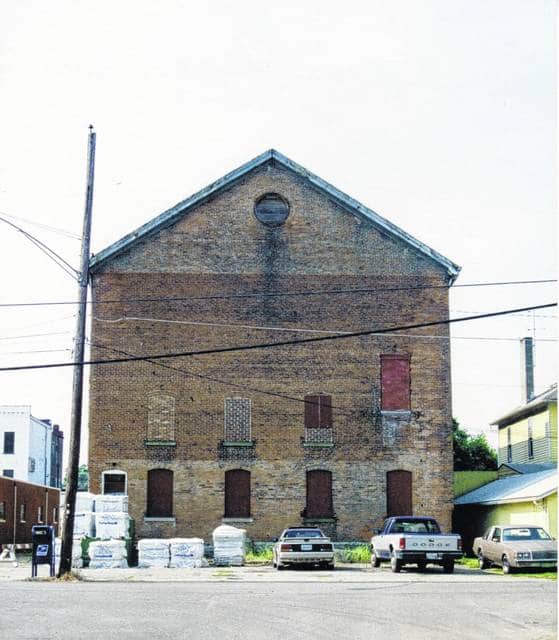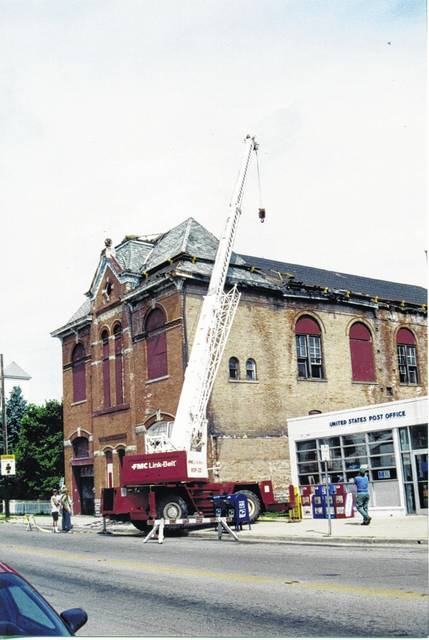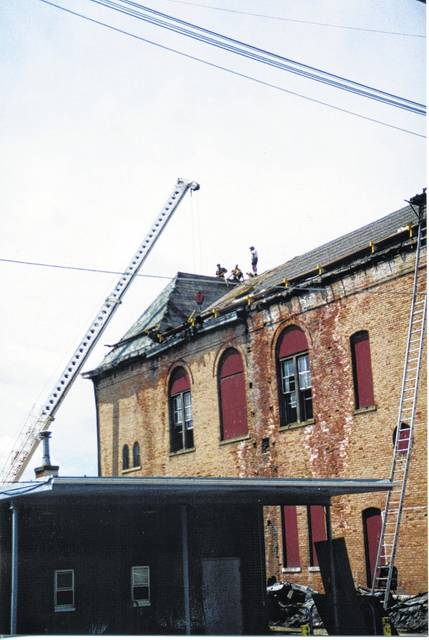


CAMDEN — The Village of Camden has had a town hall since May 11, 1889, but in 1988 a fire of unknown origins destroyed it.
Since then, the village has been operating out of a rented building. There have been several attempts to rebuild and renovate the old building, over the years, but none had been successful until Camden Village Council approved renovation plans two years ago.
Now, the Camden Town Hall will hold its official grand opening on Thursday, May 11.
Village staff has already moved back into the building.
Camden Town Hall has a long history, and has been touched by fire and renovation more than once through the years.
During a council meeting on Dec. 6, 1868, 74 votes were cast in favor of building a town hall and 10 votes were cast against it. On Dec. 14, 1877 it was motioned that J. L. Thomas Hewitt and James Mitchell be appointed a committee to estimate the cost of the town hall.
After many bonds were issued, the building opened on May 11, 1889 at a cost of $15,000. The hall was a combination opera house, fire department, and village hall. It quickly became the village center.
In 1904, the town hall was ordered closed by State Building Inspector until improvements were made. Toilets and water works system were installed in 1913. In 1927, Mayor M. B. Fry received a report from the Department of Industrial Relations, State Division of Factor and Building Inspection. The report stated that numerous repairs and alterations were needed to meet requirements of public building or the building would be closed for public gatherings as of June 15. As council had no funds to make the improvements, it was resolved the building would be closed and a bond issue would be sought at the coming November election.
Improvements began in the coming years. In 1929, Mayor Thomas Donohoe wrote a letter to the State Building Inspection office requesting an order from their department to proceed with the installation of “standard B fire stairs.” In 1930 interior decoration was made to the council room by Craig & Johnson and Marshall Frank Roberts.
In 1933, the town hall was reopened.
There was a fire in 1936.
City officials replaced the hardwood floor, as it was damaged during the fire. During these repairs, the town hall was closed. The State Fire Marshal informed Camden officials the town hall may be condemned in 1939. A bond issue for repairs was pending the outcome of the decision of Camden voters.
The bond issue passed.
In 1953, redecoration of the auditorium began. The town hall was thought to be opened soon. In the same year, council requested bids to repair the roof.
In 1963, the balcony was removed. A gas furnace was installed in 1966. In 1971, talk of repairing the building began again.
It was thought that without repair, the building would need be be torn down. A small tax levy was upcoming.
Then, a fire destroyed the building on Dec. 22 1988.
The cause of the fire is still unknown, but following the fire the Ohio Fire Marshal’s office said it began by accident. The town hall was insured, but minimally. Following the fire, people did not know what to do. It was thought — again — the building would be tore down.
According to current Camden Village Council member Kelly Doran, Camden resident Jack White was instrumental in saving the town hall.
“After the building burnt, Jack [White] put together 20-30 members and hundreds of donors,” Doran said. “This group raised money through all different means to stabilize the building and try to protect it from demolition.”
He added, many people wanted it torn down, but it was a historic building and one of the last of its kind. They decided to save it.
Over the years, White’s group raised over $200,000, part being a $75,000 planning grant the State of Ohio gave the village. That gave them the ability to hire architects and plan. It also enabled them to put a new roof on the building.
“Their fundraising and stabilization efforts saved the building,” Doran said. “Putting the roof on it was key. They also did other structural repairs to the building, where over years of neglect, damage built up.” He pointed out that while the fire condemned the building, there was also more than 50 years of neglect. The building was already falling apart before the fire.
White’s group worked for years to stabilize the building.
In 1990, White put a proposal together for council to renovate the building, top to bottom. It was going to cost $250,000 total.
The project was not funded by the village and its residents.
“Nobody wanted to pay $250,000,” Doran said. “But now, if you go back and figure the time value of money and opportunity cost, we’ve spent almost $300,000 in rent. People didn’t want to spend the money in 1990, but we did anyway.”
They went to the state to get funding. At this point, the village was going to do a total historical renovation of the building through historic tax credits. Doran said it was “complicated.” They had to follow a historic code — for example, they could not use plywood in the building.
“We thought we were going to get funded, but then our architect died,” he said. “Right in the middle of this. The man had most of our planning money and when he died, that office closed and when that closed, there went our project. We had no one to pick it up. This was 10 or 12 years ago.”
This left the building stable, but boarded up. Someone had to pick up this project or the Camden Town Hall was going to stay uninhabitable.
It was Camden’s Village Council which eventually continued the renovation plans.
(Editor’s note: This is the first in a series of articles detailing the life and times of the Camden Town Hall and its rehabilitation. Watch for additional information in an upcoming article.)




